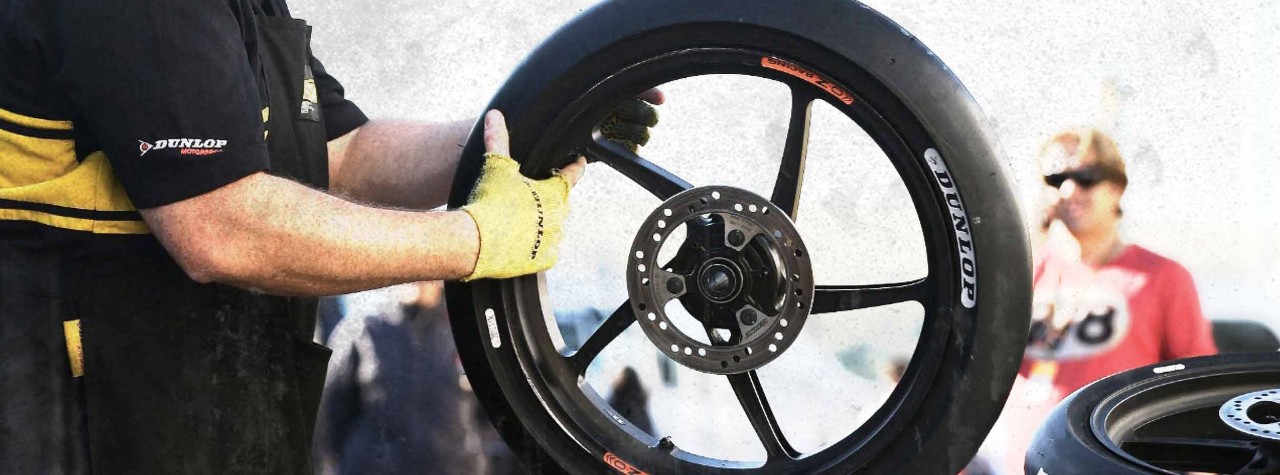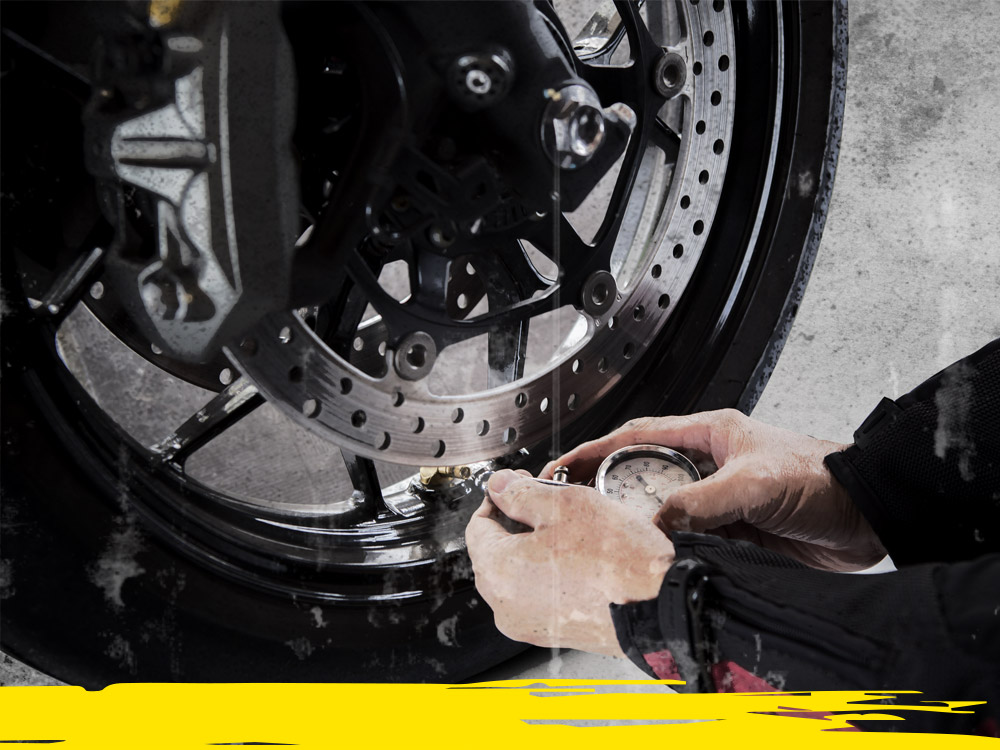
LOOKING AFTER YOUR RIDE.
Caring for your bike and your tyres is one of the most important things you can do. Regular maintenance will keep both in good condition, so you can just ride.
Our care and maintenance guide below will help you look after your ride. For additional safety information, read your bike’s owners manual and any safety decals.
BIKE MAINTENANCE
----------
We strongly recommend regularly inspecting your motorcycle generally, and the wheels in particular. Tyre mileage and performance are adversely affected by a poorly maintained vehicle. Take your motorcycle to a dealer for regular maintenance checks, including tyre inspections.
Maintain the suspension settings in strict compliance with your owners manual. Incorrectly maintained components and incorrect or unbalanced front fork settings will affect stability and generate excessive stresses on tyres.

Checking your tyre pressure is the most important type of tyre maintenance. Check cold tyre pressure frequently with a good-quality gauge on a weekly basis.
Underinflated tyres can result in imprecise cornering, higher running temperatures, irregular tread wear, fatigue cracking, overstressing and eventual failure of the tyre carcass, or loss of control, which could cause accident, injury or death. Overinflating tyres does not increase load-carrying capacity, but will result in a harsh ride and accelerated tyre wear in the centre of the contact patch.
Keep in mind that hard cornering, passengers, heavy loads and sustained high speeds will require higher pressures (up to that indicated on the sidewall). For high-speed, fully loaded or dual-riding touring-motorcycle applications, inflate tyres to maximum recommended by vehicle manufacturer, if applicable.
Never exceed maximum load indicated on tyre sidewall or vehicle capacity load found in owner’s manual, whichever is lower.
Loss of pressure may occur due to worn-out or badly seated valve cores. Check valve cores, and if necessary, tighten for correct seating, or remove and replace them. A metal or hard-plastic valve cap with an inner gasket should be used and installed finger-tight to protect the valve core from dust and moisture and to help maintain a positive air seal.
When replacing tyres, always inspect rim bands, tubes and valves. Replace if damaged or cracking is noted.
Repeated loss of inflation pressure may result from undetected tyre damage. Visually inspect tyres for punctures, cuts, abrasions, cracks, bulges, blisters or any other damages. The appearance of stress cracks in the tread grooves is one indicator of overload and/or underinflation. If you find evidence of tread-groove cracking, you should remove and replace the tyre immediately. This damage is permanent and non-repairable.
Damage caused by impacts, penetrations or continued underinflated/overloaded use is progressive and can result in sudden and complete tyre failure and accident, injury or even death. Always seek expert inspection of the dismounted tyre following curb, pothole or other impacts, evidence of penetration beyond the tyre surface, bulges or low pressure. Do not continue riding on such tyres. Inspect your tyres frequently for damage and always heed warning signs such as vibration, handling instability, rubbing or tyre noise that occurs during operation of your bike.
Replacements for worn, differently patterned or constructed tyres will not react the same. When you get new tyres fitted, do not subject them to maximum power, abrupt lean-over or hard cornering until you’ve covered a reasonable run-in distance of approximately 100 miles.
This allows you to get used to the feel of the new tyres or tyre combination, find the edge and achieve optimum road grip for a range of speeds, acceleration and handling uses. Check and adjust the pressure to recommended levels after tyres cool for at least three hours following run-in.
Remember, new tyres will have a very different contact patch and lean-over edge. Mixing a new tyre with a worn tyre and mixing different pattern combinations may adversely affect the ride and handling and will require careful ride evaluation
Remember, the correct matching of front and rear tyres is important for optimum performance and handling. Mount only tyres marked ‘front wheel’ on the front position and only tyres marked ‘rear wheel’ on the rear position. Only a limited number of tyres are suited to both front and rear fitment.
A new front tyre with a worn rear tyre can cause instability and vice versa. Mixing radials, or mixing radials with bias or belted-bias tyres, may adversely affect handling and stability. This should only be done when specifically fitted and/or recommended by the vehicle manufacturer.
Many factors other than tyre incompatibility can affect the handling of a motorcycle, including the weight and height of the rider, mixing worn with unworn tyres and the fitment of luggage or fairings. Consult your bike’s manufacturer before making modifications from stock.
Tyres offering different load-carrying capacities are available. Carefully consider the weight of your bike, whether it will carry passengers and the weight of any optional equipment. Remember, the load-carrying capability of the tyres is also reduced by underinflation. It is possible to overload a tyre even though it is the size specified by the motorcycle manufacturer.
Maximum loads and the corresponding pressures are indicated on the sidewall of all Dunlop street tyres.
Before riding, you should determine the total weight of luggage, equipment and rider(s) to be added to your bike. The total weight of luggage, equipment and rider(s) must never exceed the vehicle load capacity found in the motorcycle owner’s manual.
Tubes are a crucial part of the tube-type wheel assembly. When fitting a new tyre on a rim requiring a tube, a new tube should be fitted at the same time. Old tubes become stretched – if an old tube is fitted within a new tyre, it can crease and fail due to thinning of the tube rubber.
Tubes should be repaired only by an expert. Secure tube valve assembly to rim with care. Inspect rim band and consult motorcycle dealer for correct rim band replacement. Always check the size markings on the tube to ensure that the tyre size appears on the tube.
Tubeless tyres can and have to be fitted with inner tubes on motorcycles that are equipped with tube type tyres and rims as standard.
Use a mild soap solution to clean sidewalls, white striping or lettering. Rinse off with plain water.
Never apply any other material, cleaners or dressings to enhance sidewall appearance. These may degrade the rubber and make it impossible to check for ozone cracking or weather damage.
Tyres can be damaged as a result of poor storage conditions. This damage can affect tyre performance and function and may eventually lead to tyre failure. Stored tyres should be protected against environmental effects such as sunlight, ozone and other potentially damaging conditions.
Store tyres where the area is clean, dry, well ventilated and the ambient temperatures are temperate. Do not store tyres where the area is dirty or wet, or exposed to petroleum-based products or solvents. Or where they’re exposed to direct sunlight, extreme hot/cold temperatures or ozone-generating sources such as electric motors, battery chargers, generators or welding equipment.
Oil and fuels: prolonged contact with oil or fuels and vapours causes contamination of the rubber compound, making the tyre unsuitable for use. Wipe off any oil or gasoline immediately with a clean rag. Do not use any tyre that has been exposed to oil, combustibles, corrosives or non-rubber-compatible liquids. Motorsport and race tyres require specialised storage conditions and handling.
Only specially trained individuals should mount tyres. Improper mounting can cause explosion and serious injury.
Dunlop strongly recommend you have your tyres mounted by qualified professionals only.
Air pressure: Always maintain the recommended tyre pressure for the type of terrain you’re riding on – check your owners manual. Underinflated tyres may cause wheel damage when ridden on rocky, rough terrain and allow the bike to squirm or wander on smooth, hard terrain. Overinflation may damage the tyres and cause an unnecessarily harsh ride.
Condition: Check for cuts and gouges that may cause air leakage. Also check the tyres for missing knobs and excessively worn tread.
Wheels: To avoid loss of control or injury, make sure axle nuts are tight and secured. Grasp each tyre at the front and rear and try to rock it on its axle to detect worn-out bearings or loose nuts. There should be no free play or slip as you rock the wheel. Inspect wheels for broken or loose spokes and for cracks on the hub or rim.


